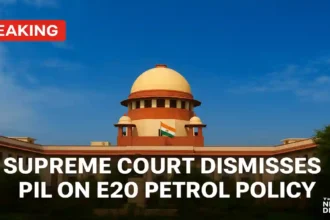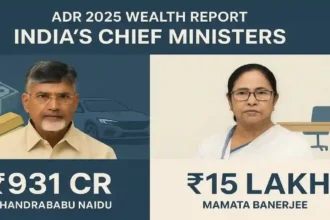
In a significant development that could impact millions of car owners across India, Toyota Kirloskar Motor Pvt. Ltd. has officially clarified that E20 fuel is not advisable for vehicles originally designed for E10 fuel compatibility. This revelation came as a direct response to user queries regarding the use of higher ethanol blended fuel in vehicles like the Toyota Urban Cruiser.
This statement is not just a clarification but a wake up call for consumers, policymakers, and fuel distributors alike, as the government accelerates its ethanol blending programme under the Ethanol Blending Petrol (EBP) initiative.
What Did Toyota Say?
In a detailed communication from Toyota’s technical team, the automaker stated:
“It is not advisable to use E20 blended Ethanol. Please use E10 fuel only as mentioned in the owner’s manual.”
Furthermore, and more crucially, they added:
Usage of any fuel (other than recommended as per Owner’s Manual) will void Toyota Warranty for the impacted parts.”

This implies that any consumer who uses E20 fuel in an E10 compatible vehicle risks losing their vehicle’s warranty on major components like engine, fuel system, sensors, and beyond.
What is E20 Fuel and Why is India Pushing for It?
E20 fuel refers to petrol blended with 20% ethanol. It is part of the Government of India’s plan to reduce dependency on imported oil, lower emissions, and promote the use of renewable energy sources. The EBP programme aims to increase ethanol blending to 20% by 2025.
While the environmental and economic rationale is clear ethanol is domestically produced and burns cleaner than petrol the transition is far from straightforward.
Many vehicles currently on the road were designed before this shift and are only tested for E10 fuel petrol blended with 10% ethanol.
Real Risks of Using E20 in E10 Compatible Vehicles
While the government pushes forward, automobile manufacturers are cautious. The reason? Ethanol has very different physical and chemical properties compared to gasoline:
Corrosive Nature: Ethanol can corrode parts not designed for its composition, especially metal and rubber components.
Water Absorption: Ethanol absorbs water from the atmosphere, which can lead to phase separation and fuel system damage.
Different Combustion Properties: Ethanol burns differently and can impact engine timing, performance, and longevity.
In simple terms, using E20 fuel in an E10 vehicle is like putting diesel in a petrol engine it may run, but the long term damage is inevitable.
Why the Warranty Voids Matter
Warranty is not just a marketing feature it’s a legal contract between the manufacturer and the consumer. When Toyota explicitly states that warranty will be voided, it is protecting itself against avoidable claims and costly repairs. This could mean:
- Engine failure? Not covered.
- Fuel pump issues? Not covered.
- Check engine light due to ethanol sensors? Not covered.
The customer ends up paying out of pocket for damages induced by using the “wrong fuel”, despite that fuel being legally available at petrol stations.
A Gap Between Fuel Policy and Vehicle Readiness?
This controversy reveals a glaring disconnect between fuel policy and vehicle readiness. The government’s plan assumes a seamless shift to E20 fuel. But millions of Indian vehicles on the road today were never designed for E20.
While the government has instructed Oil Marketing Companies (OMCs) to label E20 pumps and maintain E10 availability during the transition, ground level execution is spotty at best. In smaller towns and rural areas, consumers may unknowingly fill E20 fuel without realising the implications. This leads to a critical policy question:
Shouldn’t the government mandate dual dispensing (E10 and E20) for at least the next 5–7 years?
Suggested Reading: Is Ethanol Blending Hurting Indians? Garvit Sethi’s Letter to Nitin Gadkari Goes Viral
What Should Car Owners Do?
Toyota’s advisory is clear, and applies not just to the Urban Cruiser but potentially all Toyota vehicles not certified for E20. Other manufacturers may follow suit, or have already issued similar advisories. What consumers must do:
- Check your owner’s manual: It explicitly states the fuel compatibility.
- Ask fuel stations for E10 availability.
- Keep receipts or evidence of fuel type used, in case warranty issues arise later.
- Raise awareness among fellow drivers, especially those who may not be aware of the technical differences.
The News Drill Opinion: Right Policy, Wrong Rollout?
We at The News Drill support the long term vision behind India’s ethanol push. Reducing oil import bills, improving air quality, and supporting sugarcane farmers are all noble goals.
- But the execution appears flawed.
- How do we justify rolling out E20 without certifying the majority of the vehicle fleet?
- Why is there no nationwide education campaign for consumers?
- Where is the accountability mechanism if a consumer is misled or ends up unknowingly damaging their car?
Policymaking in India often suffers from what experts call “top down haste” plans made at the Centre without sufficient ecosystem readiness. The Toyota E20 fuel warning is not an isolated event. It is a red flag.
What Can the Government Do Now?
To prevent mass warranty voiding and consumer disputes, the government must:
1. Mandate E10 availability at every fuel station during transition years.
2. Launch public awareness campaigns on how to identify the correct fuel.
3. Subsidize fuel system upgrades or offer retrofitting assistance to older vehicles.
4. Collaborate with automakers to ensure clarity and uniform messaging.
Without these steps, the ethanol dream risks becoming a nightmare for the average car owner.
Final Thoughts
The Toyota confirmation on E20 fuel usage is a landmark moment. It exposes the cracks in an otherwise ambitious green energy initiative. While the future is ethanol-blended, the present is still E10 and consumers must not be forced into adopting a fuel that their vehicles cannot safely handle.
Until mass E20 compatible vehicle adoption is in place, using E20 fuel in E10 vehicles remains unsafe, risky, and warranty voiding.
So next time you’re at the pump, choose wisely. Your engine and wallet will thank you.
Got questions about fuel policy or vehicle safety? Email us at: contact@thenewsdrill.com
Submit tips or documents: editor@thenewsdrill.com













